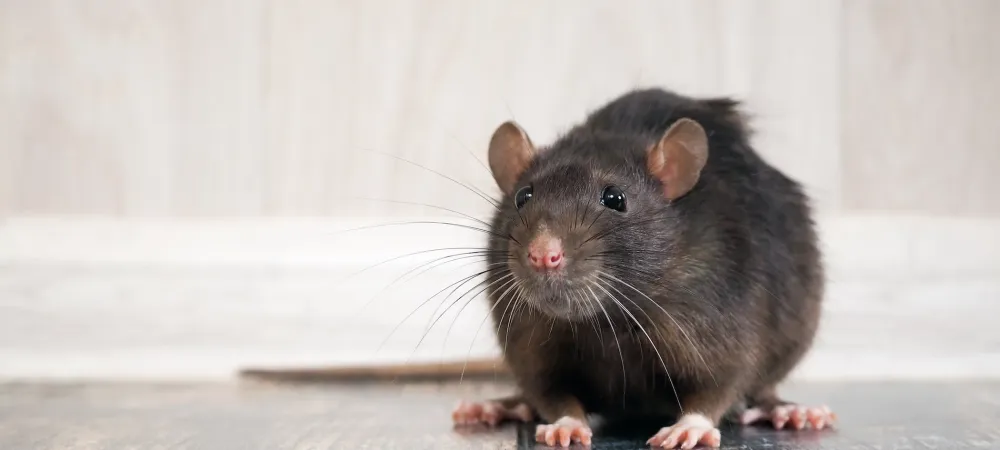Common Rodents in Antioch, Illinois

Residents here in Antioch enjoy living in the fresh air and natural environments, but that also means we have to share that space with rodents. Rodents are a particular nuisance compared to other pests because they are warm-blooded, which means they are more likely to seek shelter inside of our homes. Here is a list of the most common types of rodents found in Antioch.
Mice
Mice are small rodents that can squeeze through even the tiniest openings. They tend to live in areas of the house that humans don’t frequent, such as the basement, crawl spaces, and attic. We usually find evidence of mice when we look through old boxes and find old nests made up of cardboard, paper, and other materials. Other signs of mice include:
- Droppings
- Paw prints in the dust
- Gnaw marks on wooden beams, electrical wires, and drywall
- Piles of seeds.
- Shredded paper, fabric, or insulation.
Learn more about mice nests.
House Mouse
The most common mouse that sneaks its way into our homes is the appropriately named house mouse. House mice love to build nests in areas like basements, attics, and crawl spaces. It may look small and cute, but this pest can cost you a lot of money in damages from eating through drywall and chewing wires that could start a fire. House mice are also known to spread diseases and parasites like Salmonella and tapeworms.
Deer Mouse
Deer mice are nocturnal and spend the day hanging out in their nests. Nests are usually built out of whatever they can find such as stems, twigs, leaves, feathers, or shredded cloth. Nest sites include tree hollows, stumps, and roots, as well as the underside of rocks and logs.
As a result of their ability to spread hantavirus, deer mice are of particular concern. Due to their preference for forests, grasslands, and agricultural crops, deer mice are not normally found in residential and urban areas unless they are surrounded by fields, forests, or other suitable habitats.
How Many Babies Do Mice Have?
In addition to having multiple babies at once, mice can also have multiple litters per year. Each female house mouse is capable of having six pups every three weeks, with a second litter as early as 25 days following the first litter. They are capable of giving birth to approximately 35 babies in one year.
How Many Types of Rats Are There?
There is a lot of similarity between rats and other rodents. Due to their similarity to other rodents, it is sometimes difficult to determine what kind of pest is present in a home or building. It is important to note that rats differ slightly in appearance from species to species if you know what to look for. In Northern America, there are two common species of rats:
- Norway Rats
- Roof Rats
Norway Rats
Also known as the brown rat, Norway rats enjoy making their homes in basements and other debris. Norway rats are one of the most common rats found in cities across the country. They are generally brown or gray in color, with white on their abdomen. They range in size from 15 to 20 inches. Their tails are shorter than their bodies and have small ears and eyes. Norway rats are not picky eaters and will eat everything from pizza slices to small birds and invertebrates.
Roof Rats
Roof rats are much smaller than Norway rats, measuring 5-7 inches long. They have long ears and long tails. They are mostly found along the coast and in tropical climates. The diet of the roof rat includes:
- Seeds
- Stems
- Insects
- Pet food
- Small birds
Tips on Preventing Rats
To protect your home and safety, there are a few things you can do regularly to prevent rats:
- Norway rats can fit through an opening as small as ½ inch (or the size of a quarter). Inspect the outside of the home for any gaps or cracks and fill them with silicone caulk.
- Eliminate sources of moisture in crawl spaces and basements.
- Regularly inspect inside the home for signs of an infestation, including greasy rub marks caused by the rat’s oily fur.
Voles
Voles are small, stocky rodents similar to field mice. In fact, a vole might look like a mouse at first glance. Voles have small rounded ears that are often hidden by their fur, small eyes, and short tails. Their fur is generally thick and light brown to gray.
Voles vs Moles
Voles and moles often get confused by homeowners because they are both small brown animals that burrow under the ground. If you take a closer look, you'll see that these two animals are quite different.
Voles
- Closely resembles a field mouse
- Vegetarian
- Short tail, compact body, small eyes
- Spends most of its life above ground and burrows to make underground nests
- Has long, orange teeth
Moles
- No visible eyes or ears
- Insectivore
- Cylindrical body with short, stocky limbs, stubby tail
- Spends most of its life underground
- Large paddle-like forefeet with long claws for digging
Squirrel
While these animals are cute and widely tolerated in backyards, don’t be fooled. These rodents can invade your home and cause extensive damage. Typically, squirrels go through two breeding cycles each year, in late winter and early spring. A family of squirrels living in your attic, walls, or crawl spaces can cause significant damage by chewing through insulation, wooden beams, and even electrical wires.
What Does A Squirrel Nest Look Like?
Squirrel nests are called dreys and are constructed out of leaves, twigs, bark, moss, and other materials. You can spot a squirrel nest easily in the fall when the tree has shed its leaves. They look like large clumps of leaves that got stuck in the branches. If you notice a squirrel’s drey near your home, you can safely assume that the squirrel’s range includes your yard and home.
What Does Squirrel Poop Look Like?
Squirrel poop looks a lot like rat feces. Rats produce small, oblong-shaped droppings with tapered ends, whereas squirrels produce large, barrel-shaped droppings. It is common to find squirrel feces underneath trees, around bird feeders, and in crawl spaces inside homes and businesses.
The Best of Illinois Rodent Control
If you have had it with rodents in your home, call the pest control veterans at A-Action Pest Control. We have been providing residents of Antioch with quality rodent control for over 30 years. Our experienced and friendly staff can handle any rodent problem you may have. Just give us a call at 847-744-8538 or leave a message on our site.
How Do Rodents Get Inside Cars?
Since mice are small, they can squeeze through openings smaller than a dime. They can gain entry to vehicles by entering from under the engine. From there, they can find their way into your car. The following are among the most common entry points that mice will use to access a car:
- Vents
- Holes around cables
- Pedal shafts
- Steering columns
- Cracked windows
What Do Rodents Eat?
Most rodents tend to stick to a vegetarian and grain diet consisting of seeds, grains, and small fruit. However, mice and rats are omnivores, which means that they will eat pretty much anything that opportunity allows.
What is the Largest Rodent?
The largest rodent in the world is the Capybara. It is a semi-aquatic South American rodent that looks like a cross between a beaver and a groundhog. Capybaras inhabit the forests and wetlands of Panama and Argentina where they feed on the vegetation growing along rivers and lakes. They can grow up to 4.3 feet in length and weigh up to 174 pounds.

